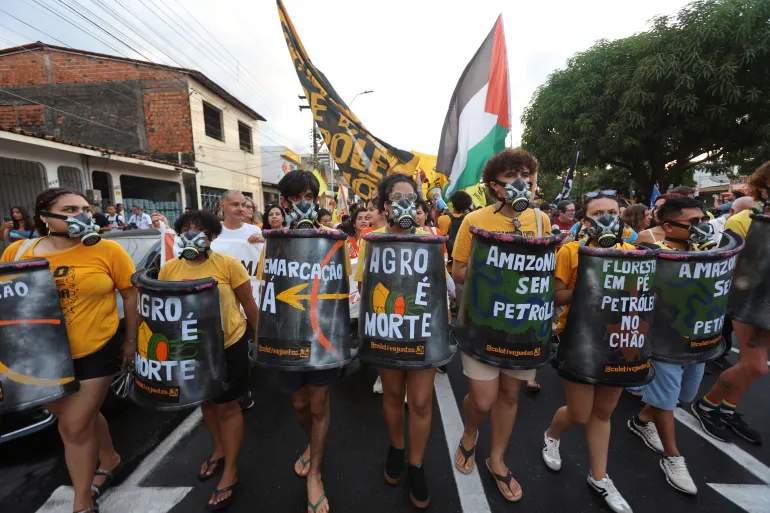The Delhi Police, appearing before the Supreme Court on Thursday, claimed that the anti-Citizenship Amendment Act (CAA) protests in 2020 were deliberately timed to coincide with US President Donald Trump’s visit to India, with the objective of attracting international media attention and amplifying unrest across the country. The statement was made by Additional Solicitor General (ASG) SV Raju, who was opposing the bail pleas of activists Umar Khalid, Sharjeel Imam, and others in the ongoing case related to the February 2020 Delhi riots.
According to Raju, the CAA protests, which began as demonstrations against the controversial citizenship legislation, were allegedly used as a “red-herring” to obscure what the police termed a larger agenda. “The ultimate intention is regime change. CAA protests were a red-herring, the real purpose was regime change, create economic deprivation and create chaos across the country. The riots were deliberately made to coincide with the visit of US President Donald Trump. These so-called intellectuals are more dangerous than the ground-level terrorists,” he argued before a bench comprising Justices Aravind Kumar and NV Anjaria.
The ASG further contended that delays in the trial proceedings were attributable to the accused and that they cannot seek to benefit from procedural delays in seeking bail. He emphasized that the accused had strategically used public protests and inflammatory rhetoric to incite violence and communal unrest.
As part of the submission, Raju presented video evidence to the Supreme Court purportedly showing Sharjeel Imam delivering provocative speeches against the CAA. The videos, collected from multiple locations including Chakhand, Jamia, Aligarh, and Asansol in 2019 and early 2020, were highlighted as instances of “inflammatory speeches” that preceded the Delhi riots. The ASG pointed to Imam’s educational background as an engineering graduate, remarking, “Nowadays there is a trend that doctors, engineers are not doing their professions but engaging in anti-national activities.” His remarks coincided with public discourse following the Red Fort suicide attack, in which several suspects were medically trained professionals.
During the hearing, the Delhi Police legal team reiterated that the riots were “pre-planned” and not spontaneous. Solicitor General Tushar Mehta, alongside Raju, argued that the accused had intentionally delayed the trial process and should not be granted bail based on procedural timelines. The police have maintained that the anti-CAA protests, particularly those in Delhi, were allegedly “sponsored” and used as a catalyst to radicalize participants and escalate nationwide communal tensions.
The Delhi Police’s submissions drew attention to the broader narrative that the protests were allegedly instrumentalized to destabilize governance structures. According to the police, the objective went beyond merely opposing a legislation; it aimed to foster widespread unrest and economic disruption, effectively challenging the legitimacy of the elected government. By coinciding with the visit of a high-profile global leader such as President Trump, the police argued that the organizers sought to amplify international scrutiny and pressure on the Indian administration.
The case before the Supreme Court involves multiple accused linked to the 2020 Delhi riots, which erupted following clashes between pro- and anti-CAA groups. The incidents resulted in significant loss of life, property damage, and heightened communal tension in the national capital. The police have consistently argued that certain activists played a strategic role in instigating violence under the guise of lawful protest, and their actions had broader implications for public order and national security.
The Delhi Police’s argument also highlighted the use of modern communication tools and social media by the accused to mobilize crowds and disseminate messages that incited unrest. Raju described the role of activists as more dangerous than conventional “ground-level” criminals, emphasizing that educated individuals with social influence were orchestrating activities that had wide-reaching implications for the country.
In addition to opposing bail, the Delhi Police submitted that comprehensive investigation and trial procedures were necessary to ensure accountability and prevent impunity. They emphasized that the accused had allegedly leveraged protests for political ends, creating conditions that escalated into large-scale communal violence. The court was presented with evidence intended to demonstrate the premeditated nature of the riots and the coordination between key organizers.
This development follows earlier submissions made on October 30, 2025, when the Delhi Police argued that Umar Khalid and co-accused had deliberately used anti-CAA protests as a disguise and a “radicalizing catalyst” to trigger widespread communal unrest, with the purported ultimate goal of regime change. The police narrative has consistently framed the protests not merely as demonstrations against legislation but as instruments of political destabilization with organized planning behind them.
The Supreme Court is expected to evaluate the submissions carefully in light of ongoing proceedings, considering factors such as the timing of protests, the role of accused individuals in inciting violence, and the presented evidence of pre-planning. The case continues to attract attention for its implications on law enforcement, civil liberties, and the interpretation of lawful protest versus acts deemed detrimental to national security.
Through these submissions, the Delhi Police aims to convey that the CAA protests, while presented as a public movement against legislation, were strategically timed and executed to gain maximum visibility, both domestically and internationally, particularly leveraging President Trump’s visit to India as a platform for global attention. The police insist that such coordination and intent, if proven, underlines the seriousness of the accusations and underscores why bail should not be granted to the accused while trial proceedings are underway.


Leave a Reply